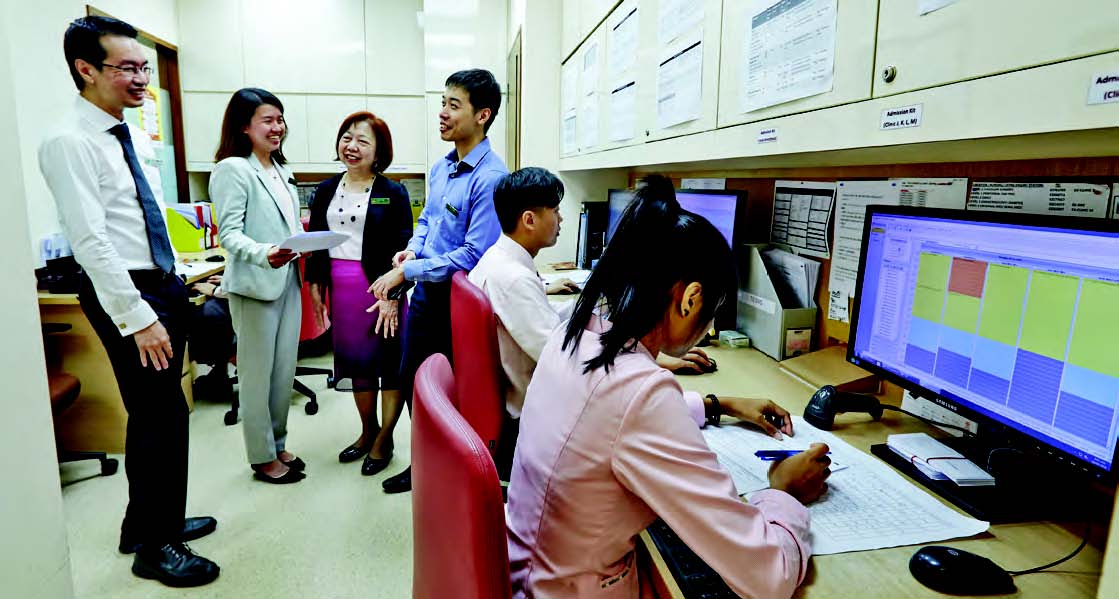
Patients no longer need to wait for over an hour for scheduled surgery date.
Some patients who plan to undergo surgery at Singapore General Hospital (SGH) no longer have to wait as long as an hour for their surgery date and other administrative details. Instead, they now receive a text message through their mobile phones informing them of the date, pre-surgery preparation and other administrative instructions.
The project kicked off in January 2016 and has been gradually implemented, with nine of SGH’s 13 surgical departments using this process. As of 2018, the new practice has benefited more than 26,000 patients who underwent surgery. By the second quarter of 2020, SGH plans to roll out the new process of scheduling planned surgery to its remaining four surgical disciplines.
“SGH firmly believes that patients should spend their time with us receiving care, not attending to administrative matters. With this conviction, we re-thought our processes to transform the way we deliver care and the way we work. We are pleased to be able to cut patient waiting time,” said Mr Lee Jiunn Kee, Deputy Director, Division of Pre-Op and Admitting Services(POAS), SGH.
In the past and for the departments that have not adopted the new practice, patients have to proceed to what is known as a listing room at their Specialist Outpatient Clinic (SOC) to arrange for a surgery date, and get pre-surgery instructions and the estimated cost of their procedure and hospital stay. On average, patients wait about 30 minutes to be seen by the Listing Nurse, who takes another 15 minutes or so to validate the patient’s particulars and other information. The actual time that the Listing Nurse takes to discuss with the patient what to do in the days leading to his surgery, as well as what to expect for his surgery, is less than 10 minutes. Apart from the waiting time, the listing room can also get uncomfortably congested, said Ms Michelle Loh, Executive, POAS.
Less hassle
Patients whose surgery uses the new process can leave SGH after their clinic consultation. They will receive an SMS later the same day to notify them of their appointment date, their pre-surgery tests date and reporting location on admission day. For instance, patients going for knee replacement surgery under the Department of Orthopaedic Surgery will get pre-op instructions, such as fasting before surgery, via SMS.
Patients can make surgery-related enquiries or change the dates by calling SGH Pre-Op Coordination Centre.
For patients, receiving the SMS at home allows them to go through and understand important information like estimated surgery costs at length. They can also discuss this with their family at their leisure.
At the same time, capturing all essential information relating to a patient’s surgery electronically and integrating it with their medical records enhances patient care and safety. Their medical records contain vital information, including medical history and drug allergies.
This new process involves standardising information specific to each type of surgery in an electronic form. But it also personalises the data in that it is able to use the information within the patient’s record to highlight and prompt the surgeons about certain pre-admission tests appropriate for that patient.
The electronic form also prompts surgeons if fields are left unfilled. Another advantage is that nurses no longer have to figure out illegible handwriting.
Essentially an administrative task, this job of arranging patients’ surgery was done by nurses. For the hospital, this change in procedure means that nurses can now be deployed for clinical work while non-clinical staff are assigned to do surgery scheduling in their place.
One of many projects aimed at reducing red tape for patients, this new process is designed by a team led by Mr Lee. In addition to Ms Loh, the other members of the team are Ms Linda Lim and Mr Goh Zewei. The team from POAS won a Best Practice Medal (Workforce Transformation Category) at the National Healthcare Innovation and Productivity Awards 2019.













 Get it on Google Play
Get it on Google Play